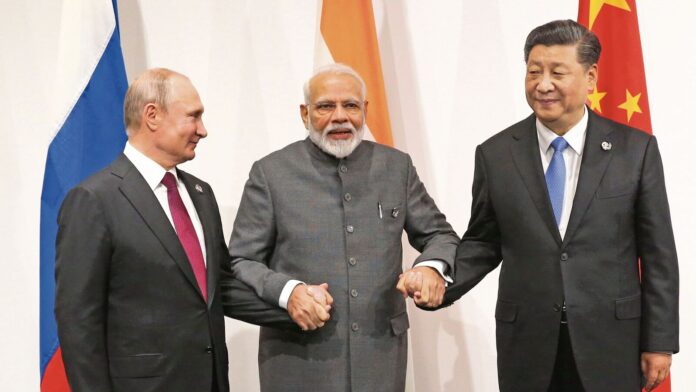It all started at the annual Munich Security Conference, which is usually a quiet affair and dominated by defence ministers, diplomats, security analysts and policy wonks as they engage in dialogue to peacefully resolve conflicts around the world. It’s been like this for 60 years, restricted initially to members of the North Atlantic Treaty Organization (Nato) and then expanded to include other nations after the Cold War ended.
The conference’s tranquillity was shattered recently after US Vice-President J.D. Vance berated European nations for straying from (what the Republican Party considers) shared democratic and liberal ideals.
Also Read: Geopolitics: Brace for a global shake-up now that Trump has rattled Nato
This came even as European leaders were struggling to overcome the previous week’s shock when US defence secretary Pete Hegseth told Nato members that Ukraine should stop hoping for the return of Russia-occupied territories and membership in the alliance.
Soon after, US President Donald Trump got on a phone call with Russian President Vladimir Putin and unilaterally offered Russia some concessions. This was followed up with a meeting between US and Russian ministers in Riyadh.Those talks took place, oddly, without Ukraine or European leaders at the table.
Look at the optics: two large nations—a hegemon and a wannabe superpower—negotiating the end of bloodshed in a third country, with about 20% of the beleaguered nation’s land offered as part of the compromise deal, without even a by-your-leave from Ukraine. Many academics have expressed apprehensions about conventional settler-colonialism making a comeback, especially after Israel’s relentless attack on Gaza, flattening neighbourhoods and killing thousands of women and children.
Also Read: Trump’s Gaza plan: There is more to a home than real estate
This sense of dread gained traction after Trump suggested that Gaza be redeveloped as a Middle Eastern Riviera and its original inhabitants be forcibly resettled elsewhere. Trump has also expressed a desire to annex—by force if necessary—Canada, Greenland and the Panama Canal.
Gaza is probably the narrow land-strip on which the world has turned, providing a key to understanding some of the tectonic shifts taking place. This is evident from Trump’s outreach attempts. In the first four weeks of his presidency, Israeli Prime Minister Benjamin Netanyahu became the first foreign premier to visit the White House, while Trump recently tore into Ukraine’s President Volodymyr Zelensky in public for allegedly starting the war with Russia, distorting the fact that it was Russian troops that had crossed Ukraine’s borders in 2022.
These events highlight a major shift in the US’s self-proclaimed role as a global protector of democratic traditions: support for Israel to wage war against a stateless population while threatening to withdraw backing for an ally under siege from an autocratic leader with expansionist ambitions.
As a Wall Street Journal report noted: “President Trump has dramatically shifted the direction of U.S. foreign policy in four short weeks, making the U.S. a less reliable ally and retreating from global commitments in ways that stand to fundamentally reshape America’s relationship with the world.”
Also Read: Anarchy or autocracy: What exactly is the Trump presidency aiming for?
Trump’s wish to leave behind an indelible legacy is also emerging pretty early. He is seeking a three-way summit with Putin and Chinese President Xi Jinping.
This is a throwback to 80 years ago, when US president Franklin D. Roosevelt, UK prime minister Winston Churchill and Soviet Union general secretary Joseph Stalin met in Yalta, in February 1945, to not only discuss the post-war reorganization of Germany and Europe, but also carve out areas of influence between themselves, without any of the stakeholder states present.
The current US president’s foreign relations tilt so far leaves Europe—a continent of the world’s original settler-colonists—out in the cold; combined with his economic and trade exertions, it presents multiple dilemmas for India’s foreign relations and economic growth strategies.
Also Read: Harsh Pant: Trump’s foreign policy recast poses a challenge that India cannot avoid
Trump seems to be specifically picking on India by bringing a grenade-launcher to a fist-fight: his repeated and high-decibel assertions about India’s unfair trade practices, and his desire to correct these, seem disproportionate to the $120-billion annual trade in goods between the two nations. Try this for size: the US-China merchandise trade is around $582 billion.
Trump’s bluster clearly masks a negotiating tactic. He probably feels India-China tensions have left New Delhi on the ropes and desperate for US security assurances, allowing him space to press for concessions.
It is evident from his utterances that he wants India’s tariff walls lowered to let US companies sell directly to some 300-400 million Indian consumers. And if the US does manage to strike some deal with China subsequently, as Trump wishes to, it will leave India with fewer bargaining chips. India thus needs to take some smart calls: lowering tariffs only where necessary, pushing for higher services exports and diversifying its trade footprint.
Also Read: Mint Quick Edit | Should Trump’s latest tariff salvos worry India?
India’s so-called strategic autonomy, or its ability to make strategic decisions in its own interests without succumbing to external pressure, is being called into play.
Independent India’s equation with the US has historically oscillated between deep suspicion and partnership. This may be the beginning of a third stage, but its tone and tenor will depend on how the Indian leadership manages to hold its own while seeking its rightful place at the global high table.
The author is a senior journalist and author of ‘Slip, Stitch and Stumble: The Untold Story of India’s Financial Sector Reforms’ @rajrishisinghal.
#world #order #emerging #India #find #place
